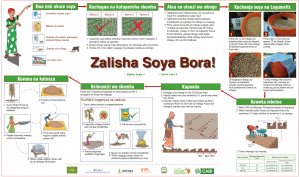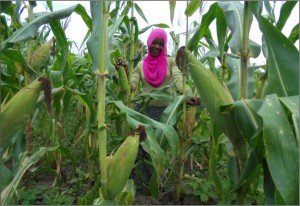Campaign-based approaches in development
7 June 2017: In both East and West Africa the ASHC team is working to develop multi-media campaign. Duncan Sones reviews the question What do we mean by a campaign-based approach?
The ASHC approach has seen us facilitating the creation of partnership across a number of organization that together can deliver a multiple-media campaign. The aim of these partnerships is to inform small-scale farming households about a particular agricultural technology, using different combinations of media.
A multiple-media scale-up campaign utilizes a variety of media and interpersonal approaches to deliver a common message, or set of agronomic messages. The aspiration is to make the same information accessible to different members of the farming household. Collectively these media and approaches can be thought of as a development communications mix:
| Media | Interpersonal approaches |
Low levels of interactivity
In the middle group the level of interaction depends on the form the media takes
High levels of interactivity
|
One to one
One to few
|
|
These are mass communications with the potential to reach farming households at scale. The unit cost of production and distribution is generally low. Some interactivity is possible. |
Interpersonal approaches are usually moderated interactions with individual farmers or farmers groups. The unit cost of delivery is high because these approaches are labour intensive |
One specific advantage of the campaign approach means that there is flexibility to change the development communications mix to meet changing needs or emerging opportunities, and to switch to media or approaches that are seen to be effective in delivering the project objectives.
Campaign approaches often involve a number of partners developing or commissioning media, or training intermediaries to deliver interpersonal approaches. There is a need for co-ordination to ensure that the messages remain consistent.
The way that ASHC partners ensure consistency across all media platforms and approaches is by developing and sharing document we call a technology brief. The technology brief is developed through participatory approaches with input from as wide a range of stakeholders as possible. Typically these will include researchers involved in the development of the technology in the area, extension, input dealers, output marker dealers, farmers’ representatives and NGOs and civil society groups active with local farmers. Where possible it is helpful to include gender expertise – especially looking at the roles and responsibilities traditionally associated with men women and people of different ages.
A soybean write-shop in Arusha
The poster that was developed over several write-shops
ASHC has developed a Practice guide: Generating farmer-friendly consistent messages using a multi-disciplinary write-shop (Word document). This guide explains how we produce the technical brief. ASHC has also shared a number of examples of technical briefs. Getting the right partners for a campaign-based approach is really important. The approach works best when it involves different types of organisations working together. Each organisation takes a different but complementary role, each making an important contribution to outputs and outcomes of the projects.
There is an important role of facilitating the partnership formation and development, and work towards a consensus on the common messages drawn from a technology brief that sets out a shared vision of the best approaches for small-scale farmers. This coordinating partner will also need to facilitate the development of a plan for media and interpersonal approaches to be included in the campaign. Because ASHC is trying to understand more about the combinations of media that are effective and how they impact on different gender groups we want to also set up learning experiments. And of course all of this needs to be delivered on budget and in the agreed time-frame.
Working out in advance the roles that need to be covered helps to ensure the best partners are recruited.
ASHC defines the five roles carried out by partners as:
- Facilitating partners (F) with convening power (the ability to get people together) and skills to facilitate a plan and map the progress against the plan
- Knowledge partners (K) with proven technologies, or practices, to share
- Research partners (R) that work with the team to learn lessons and assess outcomes
- Input partners (I) that are keen to establish sustainable supply chains for the required inputs –usually private sector
- Delivery partners (D) using different media and/or interpersonal approaches to reach farmers
This is not a comprehensive list of roles. To some extent the roles will depend on the nature of the campaign and approaches. There could be strong arguments for having output market partners (or combining the input and output partner into market partners). Teaching and learning partners may be important – universities building the next generation of professionals, schools delivering learning materials based on the technology you are promoting. You may also want advocacy partner who can help present the arguments for a change in policies, regulations or the way that existing regulations are implemented or enforced.
What media should be included in a campaign?
The choice of media and approaches that are include in the campaign will have a big impact on who gets first-hand information on the technology.For example, radio and village film screenings have a good track record of reaching whole families; whereas the majority of people responding to interactive segments on the radio in our experience are younger men; men tend to have access to mobile phones and household heads tend to be the ones that attend farmers meetings, extension session and carry out purchases at the agro-dealers. Younger people can be reached through comics, curriculum enrichment materials supplied to schools – to be successful the style and language of materials for a school and materials as part of youth culture would be very different.
Targeting different media and approaches at different members of the farming household can overcome the challenges of trying to produce a one size fits all solution. For example, it is hard to support people with low literacy wanting information of food security and provide comprehensive information (including full information on the techniques, benefit: cost breakdowns and follow-up information – such as where to get inputs and access markets) meeting the needs of farming looking to maximize their profits and feed their families. In some cases women may be looking for different information – such as turning crops into value-added products, or explanations about nutritional content.
If you have well planned campaigns and clear research objectives, you can test how different combinations of media and approaches work in different context. It is unlikely that one method alone will do everything. For example demonstration plots are great at raising awareness of a new approach or variety – but then farming households struggle to remember the detail – so they need print or phone messages to reinforce the details.
At ASHC we try to provide information from land preparation to post harvest – even when our priority is promoting a new variety of seed. Farmers need to see how technologies fit together and we cannot be sure when others will come along to provide the missing information!
We believe that a multiple-media campaign is a good approach because in Africa the whole family gets involved in farming. With a campaign based approach we can support all the family members in their attempts to implement the improved technologies. There is also some evidence that providing different family members with information can be very empowering and can have an impact on the way that decisions are made about farming practices within the household.
We found a good example of this in Tanzania when we distributed Shujaaz. We published a blog called Father and daughter bond over ISFM comic This articles explains how a young woman found out about maize farming from a comic which she read to her father. The reading become a conversation and the father realized that his daughter could help him to introduce smarter farming approaches. This shows the potential of a campaigns-based approach to impact gender equality.
In other cases the gender differences can be harder to explain. In another blog called AFAP common bean farmer field days attract young farmers, we shared the gender breakdown of a series of farmer training days. Whilst many of the farmers were under 35, the number of women attending varied from 17% to 60%. All the events were the same, the villages were culturally very similar and the approach relied on extension workers to invite the farmers. There seems to have been some significant differences in the way that some extension agents work – with very different impacts in terms of women’s empowerment. Choosing the right media or approach is the first step but making sure it is delivered in an inclusive way is equally important.
ASHC commissioned a film that has very practical advice on how to facilitate women’s access to interpersonal approaches. In Women in extension women explain what they need to be able to access extension services and flourish as farmers.
If you want to know more please read the media guide to developing a multiple media campaign.






